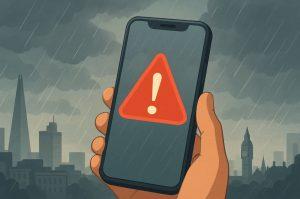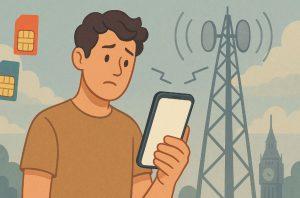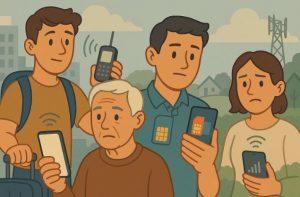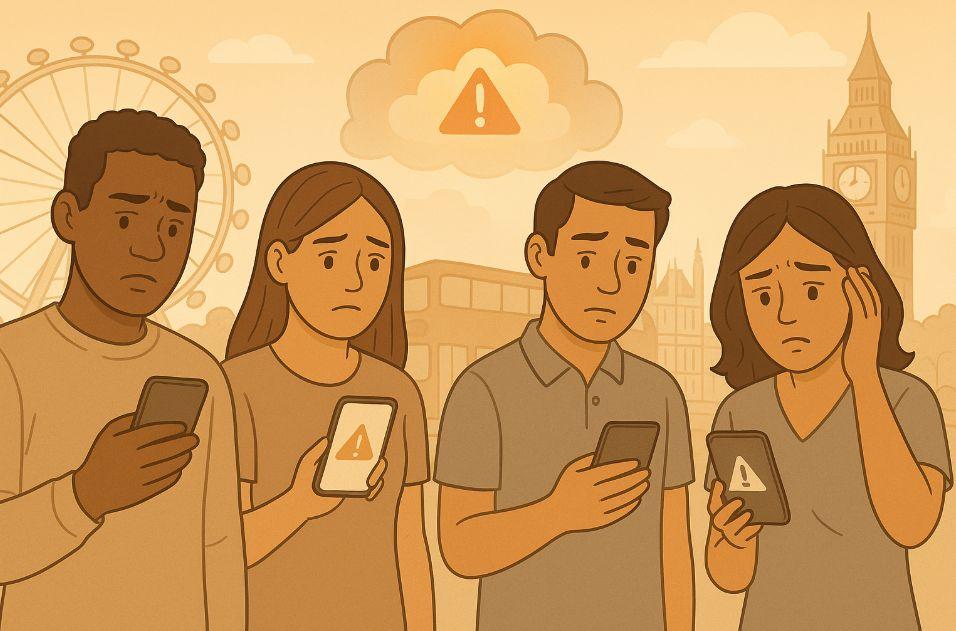Emergency alerts are designed to inform and protect the public in situations that present a serious threat to life. The UK Government launched its national Emergency Alerts system to ensure that people receive timely warnings during critical incidents such as extreme weather events, public health threats, or terror attacks.
However, many individuals across the UK especially in London have reported not receiving the recent test alert. If this happened to you, understanding why and knowing how to fix it is essential for your safety.
Why Was an Emergency Alert Sent Out in the UK?

The government initiated the Emergency Alert system to offer rapid communication during emergencies. On 23 April 2023, a national test alert was issued to assess how the system performed across different devices and networks.
This test was also an opportunity for the public to understand what the alert looks and sounds like. In future situations where lives may be at risk such as major floods or industrial accidents alerts like this will help people take immediate protective action.
These alerts are not sent out lightly. They are intended for circumstances where failure to inform the public could result in significant harm or loss of life.
What Should You Do If You Didn’t Receive the Emergency Alert?
If your phone did not receive the alert, the first thing to do is remain calm. There are multiple reasons why this may have happened, many of which are easy to fix. Begin by checking whether your phone supports the alert system. Even if you own a relatively modern device, certain models may not be compatible with the technology used for emergency broadcasts.
Next, confirm that the software on your device is updated to the latest version. Emergency alerts are typically enabled by default, but outdated operating systems may prevent them from working correctly. It’s also worth reviewing your notification settings to ensure that government alerts haven’t been accidentally switched off.
In some cases, issues may be tied to the mobile network provider or your specific location at the time of the alert. If you were underground, inside a building with thick walls, or temporarily out of signal range, your device may have failed to receive the broadcast.
Which Devices Are Compatible With the UK Emergency Alert System?
Not every device is capable of receiving UK emergency alerts. For iPhone users, devices running iOS 14.5 or later are supported, and alerts are usually switched on by default. Android users need to be on Android 11 or newer, although exact compatibility can depend on the brand of the phone.
Older handsets, such as feature phones or devices purchased outside the UK, may not support the technology used in the alert system. In addition, imported smartphones or grey-market models might lack the regional firmware required for these alerts to function correctly.
If you’re unsure whether your device is eligible, check the settings or consult the manufacturer’s website. Device support is an essential first step to ensuring you’re kept in the loop during an emergency.
Could Your Network Provider Be the Reason You Missed the Alert?

Yes, mobile network providers play a significant role in the successful delivery of emergency alerts. While major networks such as EE, Vodafone, Three, and O2 were involved in the alert test, network conditions at the time may have impacted delivery.
If your phone was switched off, in flight mode, or outside of mobile signal range, you would not have received the alert. Additionally, some users on mobile virtual network operators (MVNOs) like GiffGaff, Tesco Mobile, or Smarty may experience inconsistent support for emergency alerts depending on how these networks access infrastructure from the larger providers.
It’s advisable to reach out to your provider and ask whether emergency alert support is active for your SIM card and region. They can also help troubleshoot further if you were expecting the alert and didn’t receive it.
How Can You Check and Enable Emergency Alerts on Android Phones?
Android users can verify their settings by navigating to the Notifications menu within the device settings. The placement of emergency alert options may differ slightly depending on the manufacturer, but in most cases, you’ll find them under “Wireless Emergency Alerts” or “Advanced Settings.”
From there, users can toggle different types of alerts on or off, including extreme threats, severe threats, and public safety notifications. It’s also a good idea to keep your software updated and restart your phone after making changes to ensure they take effect.
For phones using custom user interfaces such as Samsung’s One UI or Xiaomi’s MIUI the alerts may be hidden within additional menus, so it may require a quick search within the settings.
How Do You Check Emergency Alert Settings on iPhones?
For those using Apple devices, checking emergency alert settings is relatively straightforward. Within the Notifications section of the Settings app, scroll down until you find the “Government Alerts” section. Here, you should see options to toggle Emergency Alerts and Public Safety Alerts on or off.
These alerts are activated by default on iOS 14.5 or later. If you don’t see the options listed, it could indicate that your iPhone is running an older version of iOS, in which case updating the software should resolve the issue.
Make sure the “Do Not Disturb” or “Focus” mode wasn’t enabled at the time of the alert, as this may also interfere with the notification display even though alerts are designed to override silent settings.
Are Certain Users More Likely to Miss Alerts?

Yes, certain factors can increase the likelihood of missing an alert. For example, tourists or international visitors using non-UK SIM cards may not receive the broadcast if their phones aren’t registered with UK networks. Similarly, dual-SIM users could miss alerts if their primary SIM is foreign or inactive.
People living in rural or remote areas with poor signal coverage are also at a higher risk of missing alerts. In addition, individuals who keep their devices on silent, flight mode, or with battery saver settings aggressively enabled might not receive notifications as expected.
Understanding these potential barriers can help users take proactive steps to ensure they’re not left out during a critical situation.
What Troubleshooting Steps Can Help Fix Emergency Alert Issues?
If you suspect something is wrong with your phone or settings, a few technical adjustments can usually help. Start by restarting the phone and checking for software updates. These simple steps often fix most minor configuration issues.
If you’re still not receiving alerts, ensure that your SIM card is properly inserted and registered with a UK network. You can also try resetting your network settings or contacting your mobile service provider for further troubleshooting. They may be able to confirm whether your handset supports the service and whether any known issues affected delivery in your area.
For users who have exhausted these options and still have concerns, reaching out to Ofcom or submitting a report through the government’s emergency alerts website is recommended.
Will You Still Be Safe If You Don’t Receive an Emergency Alert?
Missing an alert doesn’t mean you’ll be completely uninformed. The UK’s emergency communication infrastructure is multifaceted and includes radio and television broadcasts, emergency service announcements, and updates via trusted news outlets.
While emergency alerts are an important tool, they are part of a broader system designed to keep the public informed and protected. Still, having every layer of communication working in your favour improves your chances of taking quick, informed action during a crisis.
How Can You Stay Informed During Emergencies Without Alerts?

If your device remains incompatible or if you missed an alert and want additional security, consider downloading trusted apps like the Met Office app or the Red Cross Emergency App. These platforms provide real-time warnings and updates on weather events and emergencies.
You can also register for local authority text or email alerts and follow relevant social media accounts like @metpoliceuk or @metoffice. Tuning into BBC Radio London or keeping a battery-powered radio at home can provide another line of defence in case of digital disruptions.
These methods ensure you remain well-informed, regardless of whether your phone is compatible with government alerts.
Which Devices Are Compatible With the UK Emergency Alert System?
The success of the UK’s Emergency Alert system depends heavily on the compatibility of individual devices. While most modern smartphones are supported, there are several factors that determine whether or not a phone can receive alerts including operating system version, manufacturer settings, and region-specific firmware.
Here’s a detailed table that breaks down compatibility across major phone brands used in the UK:
| Brand | Model Range | OS Requirement | Alert Compatibility | Settings Access Method | Notes |
| Apple iPhone | iPhone 6s and newer | iOS 14.5 or later | Fully supported | Settings > Notifications > Government Alerts | Enabled by default on supported versions |
| Samsung | Galaxy S10 and newer | Android 11 or later | Fully supported | Settings > Notifications > Wireless Alerts | Some older models may need manual activation |
| Google Pixel | Pixel 3 and newer | Android 11 or later | Fully supported | Settings > Safety & Emergency | Stock Android ensures prompt alert delivery |
| Xiaomi | Mi 10 series and newer | MIUI 12.5 / Android 11+ | Partially supported | Settings > Additional Settings > Emergency Alerts | MIUI settings vary; updates may be required |
| OnePlus | OnePlus 8 and newer | Android 11+ / OxygenOS 11+ | Supported | Settings > Apps & Notifications | Earlier models may lack native support |
| Huawei | P30 Pro and newer | EMUI 11 or later | Limited support | Not always available in settings | Lacks support in some UK firmware versions |
| Sony Xperia | Xperia 5 and newer | Android 11+ | Supported | Settings > Apps & Notifications | Region-specific compatibility |
| Nokia (Android) | Nokia 5.4 and newer | Android One (11+) | Supported | Settings > Notifications | Minimal interference from custom UI |
| Motorola | Moto G9 and newer | Android 11+ | Supported | Settings > Notifications > Wireless Alerts | Some models require manual setting adjustments |
| Feature Phones | Various models | Basic OS | Not supported | Not applicable | Do not support emergency alert broadcasts |
Conclusion
Missing an emergency alert can be worrying, but the issue is often easy to resolve. Checking your device settings, updating your operating system, and verifying your mobile provider’s support for alerts are the key steps to ensuring you’re prepared for next time.
As the UK continues to roll out its emergency alert system, staying alert pun intended means staying informed, connected, and safe. Your phone might be your first line of defence during a crisis, so it’s worth making sure it’s ready when it matters most.
FAQs About Not Receiving Emergency Alerts in the UK
Why didn’t my phone receive the UK emergency alert?
Your device might be incompatible, the settings could be disabled, or you may have been outside coverage during the alert.
Do I need mobile data or Wi-Fi to get emergency alerts?
No. The alerts use a separate broadcast channel that works through cellular networks without requiring internet.
Can I get emergency alerts on a Pay-As-You-Go phone?
Yes, provided the phone is compatible and the SIM is active and registered with a UK provider.
Are tourists or visitors able to receive alerts?
Only if their phone supports the alerts and is roaming on a UK network during the broadcast.
Will emergency alerts sound if my phone is on silent?
Yes. These alerts are designed to override silent modes with a loud alarm and vibration.
How can I report not receiving the emergency alert?
You can report issues via the official UK Government website or speak directly to your network provider.
Will future alerts cover more types of emergencies?
Yes, the system is expected to cover a range of threats including health emergencies, terror incidents, and natural disasters.









Leave feedback about this